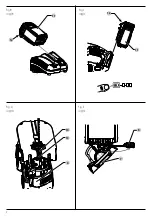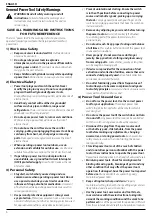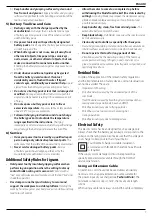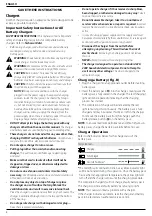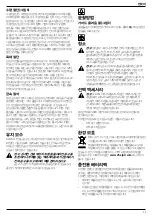
14
EngliSh
Proper Hand Position (Fig. L)
WARNING:
To reduce the risk of serious personal injury,
ALWAYS
use proper hand position as shown.
WARNING:
To reduce the risk of serious personal
injury,
ALWAYS
hold securely in anticipation of a
sudden reaction.
Proper hand position requires one hand on the main handle
9
.
Cutting
WARNING:
The jig saw should not be operated with the
shoe removed or serious personal injury may result.
Pocket Cutting (Fig. M)
A pocket cut is an easy method of making an inside cut. The
saw can be inserted directly into a panel or board without first
drilling a lead or pilot hole. In pocket cutting, measure the
surface to be cut and mark clearly with a pencil. Next tip the saw
forward until the front end of the shoe sits firmly on the work
surface and the blade clears the work through its full stroke.
Switch the tool on and allow it to attain maximum speed. Grip
the saw firmly and lower the back edge of tool slowly until the
blade reaches its complete depth. Hold the shoe flat against the
wood and begin cutting. Do not remove blade from cut while it
is still moving. Blade must come to a complete stop.
Flush Cutting (Fig. N)
A flush cut is necessary when finishing off cuts up to a wall or
an obstacle, such as back-splash. One of the easiest ways to
accomplish the flush cut is to use a flush cutting blade (DT2074).
The flush cutting blade provides the reach necessary to cut
right up to the front edge of the jig saw shoe. Remove the
anti-splinter insert and return the shoe to the 0° positive stop
position before installing and using the flush cutting blade. For
the best cut quality the flush cutting blade should be used in
the 0 or 1 orbital position. The flush cutting blade should not be
used to start the cut because the flush cutting blade prevents
the shoe from being supported by the work surface. Use wood
cutting practices explained below.
Wood Cutting
Support the workpiece adequately at all times. Use the higher
speed setting for cutting wood. Do not attempt to turn the tool
on when blade is against material to be cut. This could stall the
motor. Place the front of shoe on the material to be cut and hold
the jig saw shoe firmly against the wood while cutting. Don’t
force the tool; let the blade cut at its own speed. When the cut
is complete, turn the jig saw off. Let blade come to a complete
stop and then lay the saw aside before loosening the work.
Metal Cutting
In cutting thin gauge sheet metals, it is best to clamp wood to
the bottom of sheet metal; this will insure a clean cut without
the risk of vibration or tearing of metal. Always remember to use
a finer blade for ferrous metals (for those that have a high iron
content); and use a coarser blade for non-ferrous metals (those
that do not have an iron content). Use a high speed setting
for cutting soft metals (aluminum, copper, brass, mild steel,
galvanized. pipe, conduit sheet metal, etc.). Use lower speed to
cut plastics, tile, laminate, hard metals, and cast iron.
MAINTENANCE
Your
D
e
WALT
power tool has been designed to operate
over a long period of time with a minimum of maintenance.
Continuous satisfactory operation depends upon proper tool
care and regular cleaning.
WARNING: To reduce the risk of serious personal
injury, depress the trigger lock button and
disconnect battery pack before making any
adjustments or removing/installing attachments or
accessories.
An accidental start-up can cause injury.
The charger and battery pack are not serviceable.
Lubrication
Lubricating the Guide Roller (Fig. D)
Apply a drop of oil to the guide roller
14
at regular intervals to
prevent jamming.
Cleaning
WARNING:
Blow dirt and dust out of the main housing
with dry air as often as dirt is seen collecting in and around
the air vents. Wear approved eye protection and approved
dust mask when performing this procedure.
WARNING:
Never use solvents or other harsh chemicals
for cleaning the non-metallic parts of the tool. These
chemicals may weaken the materials used in these parts.
Use a cloth dampened only with water and mild soap.
Never let any liquid get inside the tool; never immerse any
part of the tool into a liquid.
Optional Accessories
WARNING:
Since accessories, other than those offered
by
D
e
WALT
, have not been tested with this product, use
of such accessories with this tool could be hazardous.
To reduce the risk of injury, only
D
e
WALT
recommended
accessories should be used with this product.
Consult your dealer for further information on the
appropriate accessories.
These include:
– DE3241 Parallel guide
– DE3242 Trammel bar
Protecting the Environment
Separate collection. Products and batteries marked
with this symbol must not be disposed of with normal
household waste.
Products and batteries contain materials that can
be recovered or recycled reducing the demand for raw
materials. Please recycle electrical products and batteries
according to local provisions. Further information is available at
www.2helpU.com
.
Summary of Contents for XR DCS334
Page 1: ...DCS334 DCS335 ...
Page 2: ...B Copyright DeWALT English 5 한국어 16 ...
Page 3: ...1 Fig A 그림 A DCS334 4 5 6 8 7 1 2 3 9 DCS335 5 6 7 1 9 3 8 10 4 10 ...
Page 4: ...2 Fig B 그림 B Fig C 그림 C Fig D 그림 D Fig E 그림 E 12 12 11 11 14 13 4 8 7 ...
Page 6: ...4 Fig L 그림 L Fig M 그림 M 9 DCS334 DCS335 9 Fig N 그림 N ...
Page 28: ...N696976 05 2019 ...



